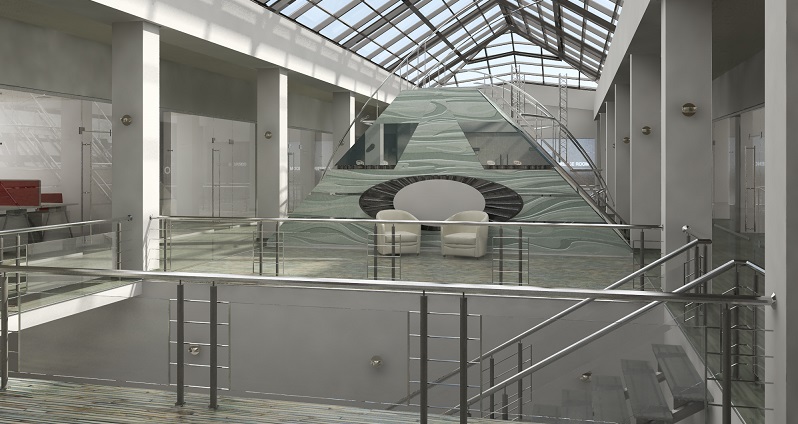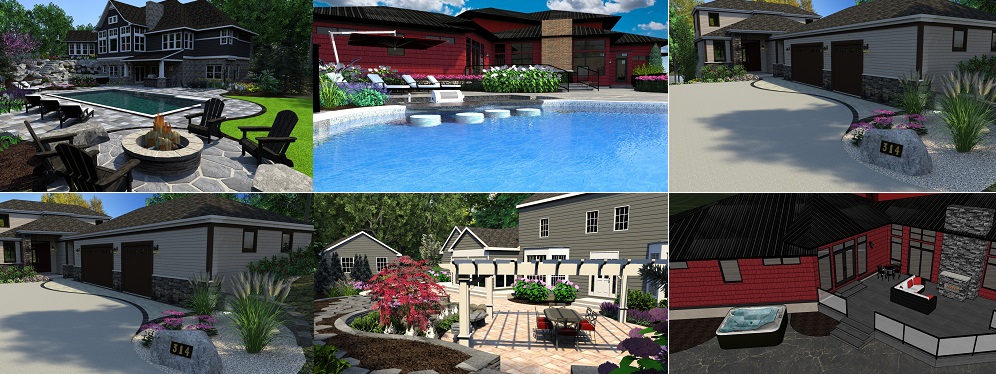In simple words, 3D modeling is the process of developing three-dimensional objects or characters using specialized computer software. The most significant difference between 2D and 3D drawings is that the latter feels more realistic (some may call it hyper-realistic) because every single detail in the frame is technically drawn to be a digital true-to-life representation of the actual physical object.
Some 3D models are static while others are animated, and all with the same purpose: to help audiences understand the objects more clearly through three-dimensional representation. Let us take a look at the samples below:

On the left is a bottle of soft drink, and on the right is a fantastical drone—both are the result of the 3D visualization process. You may think that the image on the left is a photograph, but then you realize that the spaceship-like object is just as realistic. The biggest difference between a photograph and a 3D model is that the latter has no limit in what you can create. Everything can be drawn, including objects that exist only in your imagination, yet the result can be as realistic as it can be.
The basic process of drawing is as follows:
- Understand the concept: Regardless of what you want to draw, it’s easier if you have a rough sketch of what the object should look like. This is especially important when the objects are imaginary, such as fantastical characters or spaceship-like robots, as seen in the image above.
- 3D modeling services: You use specialized computer software to build the 3D model. To a certain extent, it’s like creating the frame or the basic support structure of a statue or any physical object, except this time the object exists as a digital file.
- Texturing: To make the model resemble a physical object, you need to put some textures to wrap the frame. A 3D modeling software usually offers various material options for this purpose, such as metal, stones, wood, plastic, cloth, skin, etc. Each material also comes with many different textures.
- Lighting: Approaching the end of the process, you need to set up the light surrounding the objects to replicate real-world lighting.
- Visualization: You have to bring everything together so that the audience can enjoy the drawing as if they see a real object. This process is called rendering, or when a computer generates a realistic image based on the data you’ve created.
Once the rendering is done, the 3D objects created will look like photographs when all the lighting, shadows, and reflections are in the right place with the right angle, color, and intensity.
When people talk about 3D modeling and visualization, chances are they refer to the same thing. The final result of 3D modeling is 3D visualization through the process of rendering. That being said, some 3D modeling works do not require complex rendering processes that involve textures, materials, and lighting properties. For 3D objects that use no background at all (for example, the models used for printing or prototyping purposes) rendering is possibly required, but it doesn’t have to be as elaborate.
3D modeling is a massive industry. It offers plenty of opportunities to anyone willing to learn and practice the skills necessary to draw realistic objects on their computer. Despite the seemingly endless emergence of new modelers, the industry still needs many more talented dedicated artists to produce creative artworks for various applications including architecture, manufacturing, consumer product design, advertising, and more.
At the same time, it is a highly competitive market, where modelers from all over the world offer their specialties online as freelancers. This is not to say that 3D modeling is an easy job anybody can do; in fact, it is far from easy. You too can be a successful freelance 3D artist with determination, patience, and persistence. Here are some practical tips to help kick-off your venture as a freelance 3D modeling professional.
Learn the Basics of 3D Modeling

First, of course, you have to know the basics of what you’re going to do. The work of a 3D visualization artist is found just about everywhere, including product packaging, billboard ads, TV commercials, music albums cover arts, magazines, video games, and movies. Besides advertisements and the multimedia industry, a good portion of 3D modelers is also required in the scientific field for research or documentation. And then there are also the entire architectural and automotive worlds where 3D visualization artists are highly sought after to help draw building plans or cars’ aerodynamics models.
The main job of any 3D visualization artist is to draw a three-dimensional representation of an object, either animated or static (sometimes both), using computer software and save the results as digital files. Depending on the clients or objects, the drawings can be hyper-realistic or technical.
While it is simple to explain, 3D modeling is far more complex to learn. It is a delicate combination of the creative mind and advanced computer software.
Understand Your Niche
Now that you know how vast the world of 3D modeling is, you have plenty of options or specializations to choose from. An essential key to successful freelancing, especially in 3D visualization industry, is to focus your energy on a specific field that interests you the most. Pick a niche you know best and keep on exploring everything there is to know about that particular field.
If you like the gaming industry, try and create various fantasy characters; assuming your interest is in architecture, draw and model houses or buildings. In case transportation is what you know best, make time to design cars, buses, airplanes, or bicycles. The more knowledge you have about a field, the higher your chances of being able to create true-to-life 3D digital objects.
Use the Right Software
Once you’ve figured out the niche you want to focus on, it’s now time to choose the appropriate software to use. While these days, most 3D modeling software is equally capable of creating nearly all objects imaginable, each has a different learning curve, user interface, and rendering engine. There can be differences in additional features as well, such as cloud storage integration, file formats, and operating system compatibility. Also, make sure the software you choose offers the most comprehensive set of tools to support your specialty.
Some software packages are best used for architectural drawing services, while others are more suitable for characters and animated objects. Please understand that it may take months, if not years, until you can fully master a professional 3D modeling software. While you don’t have to know everything to start freelancing and making money, mastery almost always pays off.
Make Sure Your Computer Can Run the Software

Professional-grade 3D modeling software requires considerable computing power to run as intended. This means having a computer that meets only the minimum system requirements of the software is often not enough. Your computer must be at least equipped with an assortment of hardware that “exceeds” the “recommended” system. Smooth-running software makes your work less frustrating and even more enjoyable. The principle is not that complicated to understand: to do quality work, you need quality machines.
In 3D modeling, there is no excuse to skimp on hardware. If you can purchase specific graphics cards or widescreen monitors to play the latest computer games for fun, then you shouldn’t be reluctant to get the hardware components to run your 3D software for work. You don’t need to buy the most expensive items, but make sure that what you have is more than enough to get the job done in a reasonable time. Sometimes, this means purchasing the best components you can afford.
Even if you’re a skilled modeler, it doesn’t help if your computer takes forever to render the drawings. Although 3D modeling and rendering are two different things, they go hand-in-hand. Upgrading your processor and graphics card should be the primary focus before you get newer storage drive and more RAM.
Build a Sizable Portfolio
The best portfolio you can have is one filled with products you’ve already sold to clients that are verifiable. A portfolio is arguably the most critical part and an inevitable step into the world of freelancing. You have to show potential clients that you can do the typical grind, draw highly-demanded objects, tackle common projects, as well as innovative models to present your ability to think outside of the box. The result is a balanced portfolio consisting of various projects without straying too far from the niche. If possible, ask your peers or other professionals to show you their portfolios and use them as references.
For a budding CAD freelancer, however, that kind of portfolio is most likely too good to be true. Ask your mentors (or teachers if you are fresh out of a CAD school/classes) to help build a portfolio. Your teachers are the best people who know your capabilities, so perhaps they can refer you to clients or companies in need of your talents. Such referrals are major starting points for most (if not all) freelancers. Without a portfolio, chances are you will not get hired unless you are very lucky, and you should not count on luck.
Spread the Portfolio Around

Uploading your portfolio to freelancing websites is often not enough. Those are the best places to get hired, but many times, you have to harness the full force of the Internet to get your artwork noticed. Visit and join 3D modeling communities in online forums and social media. Share everything you can and ask your friends or followers to help spread the word about your new venture. As long as you are active online, your portfolio will spread in the virtual world like wildfire.
People will learn more about your artwork pretty quickly, and often they will visit your actual website (yes, you also have to build one) to learn more.
Freelancing Websites
Speaking of freelancing websites, rest assured that you will not run out of such places in today’s competitive market. Based on the way you get hired, there are basically two types of freelancing websites: a marketplace where you have to place a bid for a project, and another is an agency where buyers see your profiles then purchase your service. Regardless of which type you use, being competitive in price and product is the way to go. Here is how it usually works:
- You register to the website and create a profile including portfolio
- See the job postings
- Place a bid or create an offer through a messaging platform
- If you get hired, the buyer will let you know
- Deliver the work and earn money
Make sure to sign up with a freelancing website that actually caters to the 3D design industry. All jobs posted on such a website are related to the field, and in many cases, there is a broader range of 3D modeling tasks as well compared to the more general freelancing sites. Take Cad Crowd as an example; it is like a job board with a long list of services for almost every niche. Under the 3D modeling design category alone, there are the following:
| 3D Animation Services 3D Architectural Modeling 3D Character Animation 3D Character Modeling Services 3D Design Services 3D Flythrough 3D Furniture Modeling Services 3D Logo Design 3D Modeling 3D Models of Machine Parts 3D Presentation Design | 3D Printing Design 3D Product Animation 3D Product Modeling 3D Rendering Services 3D Rigging 3D Sculpting 3D Solid Modeling 3ds Max Modeling Services Assembly Modeling Services Blender 3D Modeling Services Maya 3D Modeling Services |
And then in the 3D Rendering Services category:
| 3D 360 Degree Panorama 3D Aerial Rendering Services 3D Architectural Rendering Services 3D Architectural Site Plan Rendering 3D Commercial Rendering 3D Construction Rendering 3D Exterior Rendering 3D Furniture Rendering 3D Highrise Rendering 3D Home Rendering 3D House Rendering | 3D Interior Rendering 3D Interior Visualization 3D Landscape Rendering 3D Product Rendering and Design 3D Real Estate Rendering 3D Residential Rendering 3D Virtual Reality Rendering HDR Rendering Mechanical 3D Rendering Real-Time Ray Tracing (RTX) |

Other categories (also filled with more specific services) include CAD Design, Architectural Design, Engineering, Product Design, Consumer Products, Manufacturing Services, Invention Design Help, and more. There are other alternative freelancing websites indeed, but for 3D modeling and visualization, Cad Crowd is the place to be for both beginner and experienced modelers and rendering artists.
Another kind of freelancing is to sell your models directly to buyers. Instead of making the portfolio accessible online, you are posting ready-made 3D models for sale. It is like having an online store for your creations, but you must understand that the marketplace often requires you to pay a percentage of the sale price per product sold as commission. Some well-known websites for this include Turbosquid, SketchFab, and CG Trader.
Start Small
Competitiveness and experience are two inevitable factors based on which buyers make their decision to hire 3D modeling freelancers. A portfolio is your primary resource to showcase what you’re capable of, but never assume that you’re the only one with a shiny collection of previous work. On every freelance website, customer reviews play a huge factor in determining future success and steady workflow, hence income. No matter how impressive your portfolio is, the lack of work experiences (on the website) will hinder your progress.
By working as a freelancer, you do all the work on your own, including marketing. Always consider the first job you get as the most important, and you must decide carefully how much you will charge for it. Setting the price too high may not be a viable option if you’re a beginner; in fact, you may need to charge the lowest possible amount. Start by offering your services for free; while this is a hard pill to swallow, it is the best way to jump-start the undertaking.
Set your own limitations. For example, you will work for free for the first 5–10 jobs and then set the price accordingly. Use the customers’ reviews as consideration when thinking about the price. 3D modeling is supposed to be a rewarding job, whether you work full-time for a studio or as a freelancer. Accepting low-to-zero pay is only worthwhile during the first month or two when you’re building a reputation. As soon as you improve the experience level, you should charge the amount that is actually worth it.
Research Other Artists’ Artwork
To help set the right price for the services you offer, make time to research the market by taking a look at the quality of work other freelancers provide, how much they charge, and the price range that sells the most. Start on the same freelancing website before exploring external sources, including the artists’ own websites.
Chances are, you will find other freelancers who offer a much higher price for lower quality work than yours, but skilled artists capable of making impressive 3D models are hired by high-profile clients.

Get Connected with Other Professionals
For every new 3D modeler working as a freelancer, getting hired is the most elusive thing. Getting in touch with more experienced professionals can be a great starting point. Their advice and suggestions will help you stay on the right path to getting a more constant workflow. With any luck, those professionals may be overwhelmed with their current workload and ask you for assistance. Positive feedback from fellow freelancers means a lot.
Stay Away from Procrastination
Don’t let procrastination get in your way. Everybody says that freelancing means setting your own time for work, but this does not necessarily mean you can be lazy when it is actually time to get to work. You may work from home or anywhere else, but be a good boss to yourself and never allow procrastination to win over. If you have no work to do, then it is good time to practice. You are never too busy to improve skills.
Keep On Learning
There is plenty to learn. Take one step at a time. Do your best to not get overwhelmed by both work and practice, yet never get too ahead of yourself. The world of 3D modeling is vast; even if you have mastered any particular software or skill set, there is always someone who posts an ambitious project only few dare to accept. Constant learning helps you stay prepared for all challenges on the way to success.
The Takeaway
As a freelancer, you cannot become successful overnight. Start with a small step, prepare all your tools, learn as you go, and stay motivated. You have your own strengths and weaknesses in the same way that your competitors have theirs.
The longer you’re in the business, the more skilled you get at improving those weak points in your artwork. Inspiration is found everywhere around you, so you should never run out of ideas or objects to draw for practice or perhaps for sale.
If you’re looking for freelance work at Cad Crowd, find out how it works.
